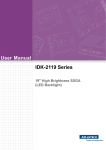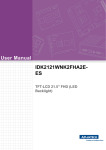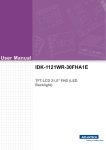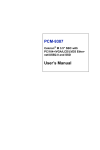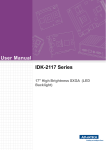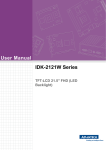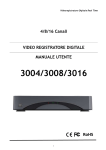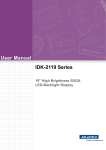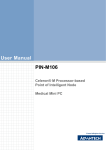Download Advantech POC-195 User manual
Transcript
User Manual POC- S195 Pentium® M Processor-Based Slim Point-of-Care Terminal with 19" TFT LCD Copyright The documentation and the software included with this product are copyrighted 2008 by Advantech Co., Ltd. All rights are reserved. Advantech Co., Ltd. reserves the right to make improvements in the products described in this manual at any time without notice. No part of this manual may be reproduced, copied, translated or transmitted in any form or by any means without the prior written permission of Advantech Co., Ltd. Information provided in this manual is intended to be accurate and reliable. However, Advantech Co., Ltd. assumes no responsibility for its use, nor for any infringements of the rights of third parties, which may result from its use. Acknowledgements Intel and Pentium are trademarks of Intel Corporation. Microsoft Windows and MS-DOS are registered trademarks of Microsoft Corp. All other product names or trademarks are properties of their respective owners. Product Warranty (2 years) Advantech warrants to you, the original purchaser, that each of its products will be free from defects in materials and workmanship for two years from the date of purchase. This warranty does not apply to any products which have been repaired or altered by persons other than repair personnel authorized by Advantech, or which have been subject to misuse, abuse, accident or improper installation. Advantech assumes no liability under the terms of this warranty as a consequence of such events. Because of Advantech’s high quality-control standards and rigorous testing, most of our customers never need to use our repair service. If an Advantech product is defective, it will be repaired or replaced at no charge during the warranty period. For outof-warranty repairs, you will be billed according to the cost of replacement materials, service time and freight. Please consult your dealer for more details. If you think you have a defective product, follow these steps: 1. Collect all the information about the problem encountered. (For example, CPU speed, Advantech products used, other hardware and software used, etc.) Note anything abnormal and list any onscreen messages you get when the problem occurs. 2. Call your dealer and describe the problem. Please have your manual, product, and any helpful information readily available. 3. If your product is diagnosed as defective, obtain an RMA (return merchandise authorization) number from your dealer. This allows us to process your return more quickly. 4. Carefully pack the defective product, a fully-completed Repair and Replacement Order Card and a photocopy proof of purchase date (such as your sales receipt) in a shippable container. A product returned without proof of the purchase date is not eligible for warranty service. 5. Write the RMA number visibly on the outside of the package and ship it prepaid to your dealer. POC-S195 User Manual Part No. 2006S19500 Edition 1 Printed in Taiwan February 2008 ii Declaration of Conformity CE This product has passed the CE test for environmental specifications. Test conditions for passing included the equipment being operated within an industrial enclosure. In order to protect the product from being damaged by ESD (Electrostatic Discharge) and EMI leakage, we strongly recommend the use of CE-compliant industrial enclosure products. FCC Class B Note: This equipment has been tested and found to comply with the limits for a Class B digital device, pursuant to part 15 of the FCC Rules. These limits are designed to provide reasonable protection against harmful interference in a residential installation. This equipment generates, uses and can radiate radio frequency energy and, if not installed and used in accordance with the instructions, may cause harmful interference to radio communications. However, there is no guarantee that interference will not occur in a particular installation. If this equipment does cause harmful interference to radio or television reception, which can be determined by turning the equipment off and on, the user is encouraged to try to correct the interference by one or more of the following measures: Reorient or relocate the receiving antenna. Increase the separation between the equipment and receiver. Connect the equipment into an outlet on a circuit different from that to which the receiver is connected. Consult the dealer or an experienced radio/TV technician for help. Warning! Any changes or modifications made to the equipment which are not expressly approved by the relevant standards authority could void your authority to operate the equipment. Caution! Danger of explosion if battery is incorrectly replaced. Replace only with the same or equivalent type recommended by the manufacturer. Dispose of used batteries according to the manufacturer’s instructions. FM This equipment has passed the FM certification. According to the National Fire Protection Association, work sites are classified into different classes, divisions and groups, based on hazard considerations. This equipment is compliant with the specifications of Class I, Division 2, Groups A, B, C and D indoor hazards. iii POC-S195 User Manual Technical Support and Assistance 1. 2. Visit the Advantech web site at www.advantech.com/support where you can find the latest information about the product. Contact your distributor, sales representative, or Advantech's customer service center for technical support if you need additional assistance. Please have the following information ready before you call: – Product name and serial number – Description of your peripheral attachments – Description of your software (operating system, version, application software, etc.) – A complete description of the problem – The exact wording of any error messages – This equipment is a source of electromagnetic waves. Before use, please make sure that there are not EMI sensitive devices in its surrounding area which may cause malfunction. Document Feedback To assist us in making improvements to this manual, we would welcome comments and constructive criticism. Please send all such - in writing to: [email protected] Packing List Before installing your Point-of-Care Terminal, ensure that the following materials have been received: POC-S195 series Point-of-Care Terminal User's manual Accessories for POC-195 – Y-shaped adapter for PS/2 mouse and keyboard – ‘Drivers and Utilities’ CD-ROM disc – DC power adapter (SINPRO Model no.MPU100-108) Mounting kits and packet of screws Warning! To prevent electric shock, Do not remove cover. No user serviceable parts inside, refer servicing to qualified personnel. POC-S195 User Manual iv Warning! 1. Input voltage rated 100-240 VAC, 50-60 Hz, 4-2 A (AC Mode) 2. Use a 3 V @ 195 mA lithium battery (Model No. BR2032) 3. Packing: please carry the unit with both hands, handle with care 4. Our European representative: Advantech Europe GmbH Kolberger Straße 7 D-40599 Düsseldorf, Germany Tel: 49-211-97477350 Fax: 49-211-97477300 5. Maintenance: to properly maintain and clean the surfaces, use only approved products or clean with a dry applicator Safety Instructions 1. 2. 3. 4. 5. 6. 7. 8. 9. 10. 11. 12. 13. 14. 15. Read these safety instructions carefully. Keep this User Manual for later reference. Disconnect this equipment from any AC outlet before cleaning. Use a damp cloth. Do not use liquid or spray detergents for cleaning. For plug-in equipment, the power outlet socket must be located near the equipment and must be easily accessible. Keep this equipment away from humidity. Put this equipment on a reliable surface during installation. Dropping it or letting it fall may cause damage. The openings on the enclosure are for air convection. Protect the equipment from overheating. DO NOT COVER THE OPENINGS. Make sure the voltage of the power source is correct before connecting the equipment to the power outlet. Position the power cord so that people cannot step on it. Do not place anything over the power cord. All cautions and warnings on the equipment should be noted. If the equipment is not used for a long time, disconnect it from the power source to avoid damage by transient overvoltage. Never pour any liquid into an opening. This may cause fire or electrical shock. Never open the equipment. For safety reasons, the equipment should be opened only by qualified service personnel. If one of the following situations arises, get the equipment checked by service personnel: – The power cord or plug is damaged. – Liquid has penetrated into the equipment. – The equipment has been exposed to moisture. – The equipment does not work well, or you cannot get it to work according to the user's manual. – The equipment has been dropped and damaged. – The equipment has obvious signs of breakage. DO NOT LEAVE THIS EQUIPMENT IN AN ENVIRONMENT WHERE THE STORAGE TEMPERATURE MAY GO BELOW -20° C (-4° F) OR ABOVE 60° C v POC-S195 User Manual (140° F). THIS COULD DAMAGE THE EQUIPMENT. THE EQUIPMENT SHOULD BE IN A CONTROLLED ENVIRONMENT. 16. If your computer clock setting is wrong or the BIOS configuration resets to default, the battery may have no power. Caution! 1. Do not replace battery yourself. Please contact a qualified technician or your retail. 2.The computer is provided with a battery-powered real-time clock circuit. There is a danger of explosion if battery is incorrectly replaced. Replace only with same or equivalent type recommended by the manufacture. Discard used batteries according to the manufacturer's instructions 17. IMPROPER INSTALLATION OF VESA MOUNTING CAN RESULT IN SERIOUS PERSONAL INJURY! VESA mount installation should be performed by a professional technician. Please contact the service technician or your retailer if you need this service. 18. CLASSIFICATION: – Supply Class I adapter – No applied part – IP54 – Continuous Operation – Not AP or APG category 19. Disconnect device: Appliance inlet. 20. Follow national requirements for proper disposal of unit. 21. Maintenance: to properly maintain and clean the surfaces, use only approved products or clean with a dry applicator. 22. Contact information: – No.1, Alley 20, Lane 26, Reuiguang Road Neihu District, Taipei, – Taiwan 114, R.O.C. – TEL: (02)27927818 23. This equipment shall not be used for life support systems. 24. Accessory equipment connected to the analog and digital interfaces must be in compliance with the respective nationally harmonized IEC standards (i.e. IEC 60950 for data processing equipment, IEC 60065 for video equipment, IEC 61010-1 for laboratory equipment, and IEC 60601-1 for medical equipment.) Furthermore all configurations shall comply with the system standard IEC POC-S195 User Manual vi 60601-1-1. Anyone who connects additional equipment to the signal inputs or signal outputs is configuring a medical system, and is therefore, responsible that the system complies with the requirements of the system standard IEC 606011-1. The unit is for exclusive interconnection with IEC 60601-1 certified equipment in the patient environment and IEC 60XXX certified equipment outside of the patient environment. If in doubt, consult the technical services department or your local representative. 25. Users are not to contact SIP/SOPs and the patient at the same time. 26. The sound pressure level at the operator's position according to IEC 704-1:1982 is no more than 70dB (A) DISCLAIMER: This set of instructions is given according to IEC 704-1. Advantech disclaims all responsibility for the accuracy of any statements contained herein. vii POC-S195 User Manual Wichtige Sicherheishinweise 1. 2. 3. Bitte lesen sie Sich diese Hinweise sorgfältig durch. Heben Sie diese Anleitung für den späteren Gebrauch auf. Vor jedem Reinigen ist das Gerät vom Stromnetz zu trennen. Verwenden Sie Keine Flüssig-oder Aerosolreiniger. Am besten dient ein angefeuchtetes Tuch zur Reinigung. 4. Die NetzanschluBsteckdose soll nahe dem Gerät angebracht und leicht zugänglich sein. 5. Das Gerät ist vor Feuchtigkeit zu schützen. 6. Bei der Aufstellung des Gerätes ist auf sicheren Stand zu achten. Ein Kippen oder Fallen könnte Verletzungen hervorrufen. 7. Die Belüftungsöffnungen dienen zur Luftzirkulation die das Gerät vor überhitzung schützt. Sorgen Sie dafür, daB diese Öffnungen nicht abgedeckt werden. 8. Beachten Sie beim. AnschluB an das Stromnetz die AnschluBwerte. 9. Verlegen Sie die NetzanschluBleitung so, daB niemand darüber fallen kann. Es sollte auch nichts auf der Leitung abgestellt werden. 10. Alle Hinweise und Warnungen die sich am Geräten befinden sind zu beachten. 11. Wird das Gerät über einen längeren Zeitraum nicht benutzt, sollten Sie es vom Stromnetz trennen. Somit wird im Falle einer Überspannung eine Beschädigung vermieden. 12. Durch die Lüftungsöffnungen dürfen niemals Gegenstände oder Flüssigkeiten in das Gerät gelangen. Dies könnte einen Brand bzw. elektrischen Schlag auslösen. 13. Öffnen Sie niemals das Gerät. Das Gerät darf aus Gründen der elektrischen Sicherheit nur von authorisiertem Servicepersonal geöffnet werden. 14. Wenn folgende Situationen auftreten ist das Gerät vom Stromnetz zu trennen und von einer qualifizierten Servicestelle zu überprüfen: 15. Netzkabel oder Netzstecker sind beschädigt. 16. Flüssigkeit ist in das Gerät eingedrungen. 17. Das Gerät war Feuchtigkeit ausgesetzt. 18. Wenn das Gerät nicht der Bedienungsanleitung entsprechend funktioniert oder Sie mit Hilfe dieser Anleitung keine Verbesserung erzielen. 19. Das Gerät ist gefallen und/oder das Gehäuse ist beschädigt. 20. Wenn das Gerät deutliche Anzeichen eines Defektes aufweist. 21. VOSICHT: Explisionsgefahr bei unsachgemaben Austausch der Batterie.Ersatz nur durch densellben order einem vom Hersteller empfohlene-mahnlichen Typ. Entsorgung gebrauchter Batterien navh Angaben des Herstellers. 22. ACHTUNG: Es besteht die Explosionsgefahr, falls die Batterie auf nicht fachmännische Weise gewechselt wird. Verfangen Sie die Batterie nur gleicher oder entsprechender Type, wie vom Hersteller empfohlen. Entsorgen Sie Batterien nach Anweisung des Herstellers. 23. Der arbeitsplatzbezogene Schalldruckpegel nach DIN 45 635 Teil 1000 beträgt 70dB(A) oder weiger. Haftungsausschluss: Die Bedienungsanleitungen wurden entsprechend der IEC704-1 erstellt. Advantech lehnt jegliche Verantwortung für die Richtigkeit der in diesem Zusammenhang getätigten Aussagen ab. POC-S195 User Manual viii Safety Precaution - Static Electricity Follow these simple precautions to protect yourself from harm and the products from damage. To avoid electrical shock, always disconnect the power from your PC chassis before you work on it. Don't touch any components on the CPU card or other cards while the PC is on. Disconnect power before making any configuration changes. The sudden rush of power as you connect a jumper or install a card may damage sensitive electronic components. ix POC-S195 User Manual POC-S195 User Manual x Contents Chapter 1 General Information ............................1 1.1 1.2 Introduction ............................................................................................... 2 Specifications ............................................................................................ 2 1.2.1 General ......................................................................................... 2 1.2.2 Power Adapter: 100 Watts Max .................................................... 2 1.2.3 Standard PC Functions................................................................. 2 1.2.4 Flat Panel Interface....................................................................... 3 1.2.5 Audio Functions ............................................................................ 3 1.2.6 PCI Bus Ethernet Interface ........................................................... 3 1.2.7 Touchscreen (Optional) ................................................................ 3 Table 1.1: Touchscreen Specification ......................................... 3 1.2.8 Optional Modules .......................................................................... 3 1.2.9 Environment.................................................................................. 4 1.2.10 Cleaning/Disinfecting .................................................................... 4 1.3 LCD Specifications.............................................................................. 4 1.4 Dimensions ......................................................................................... 5 Figure 1.1: Dimensions of the POC-S195 .................................... 5 1.3 1.4 Chapter 2 System Setup .......................................7 2.1 2.1 A Quick Tour of the POC-S195........................................................... 8 Figure 2.1: Front View of the Point-of-Care Terminal ................... 8 Figure 2.2: Rear view of the Point-of-Care Terminal ................... 9 2.2 Installation Procedures........................................................................ 9 2.2.1 Connecting the Power Cord.......................................................... 9 Figure 2.3: Connecting the power cord...................................... 10 2.2.2 Connecting the Keyboard and Mouse......................................... 10 Figure 2.4: Connecting the mouse and keyboard....................... 11 2.2.3 Switch on the Power ................................................................... 11 2.2.4 Connecting the COM Ports (COM 1, 2) ...................................... 11 Figure 2.5: Connecting the device to COM ports........................ 11 Running the BIOS Setup Program .......................................................... 12 Installing System Software...................................................................... 12 Installing the Drivers................................................................................ 12 Figure 2.6: File directory on ‘Drivers and Utilities’ CD-ROM....... 13 2.2 2.3 2.4 2.5 Chapter Chapter 3 PCI BUS Ethernet Interface ..............15 3.1 3.2 3.3 Introduction ............................................................................................. 16 Installation of Ethernet Driver.................................................................. 16 Further Information.................................................................................. 17 4 Integrated Graphic Controller Setup19 4.1 Introduction ............................................................................................. 20 4.1.1 4.1.1 Chipset............................................................................... 20 4.1.2 4.1.2 Display Memory ................................................................. 20 4.1.3 4.1.3 Display Types .................................................................... 20 Installation of the PCI Graphic Driver...................................................... 20 Further information.................................................................................. 22 4.2 4.3 xi POC-S195 User Manual Chapter 5 Audio Interface.................................. 23 5.1 5.2 Introduction ............................................................................................. 24 5.2 Installation of Audio Driver ................................................................ 24 5.2.1 5.3 Further Information ............................................................... 26 6 Touchscreen Interface...................... 27 6.1 6.2 6.3 6.4 Introduction ............................................................................................. 28 6.1.1 General Information .................................................................... 28 6.1.2 6.1.2 General Specifications....................................................... 28 6.1.3 6.1.3 Environmental Specifications............................................. 28 6.2 Installation of Driver for Touchscreen ............................................... 28 6.3 Touchscreen Calibration ................................................................... 31 6.4 Further Information ........................................................................... 32 Appendix A Description of Connectors............... 33 Chapter Figure A A.1 A.2 A.3 A.4 A.5 A.6 A.7 A.8 A.9 A.10 A.11 A.12 A.13 POC-S195 User Manual Top Side Global View of PCM-9686S A101-7 Motherboard indicates all connectors' local......................... 34 DC-in Power Connector .......................................................................... 34 Figure A.1: POC-S195 DC-in power connector .......................... 34 Table A.1: ATX Power Connector (CN21) ................................. 34 Inverter Power Connector ....................................................................... 35 Figure A.2: POC-S195 Inverter power connector ....................... 35 Table A.2: Inverter Power Connector (CN8).............................. 35 Internal Speaker Connector .................................................................... 35 Figure A.3: POC-S195 Internal speaker connector .................... 35 Table A.3: : Internal Speaker Connector (CN1)......................... 35 Front Panel Control Connector ............................................................... 36 Figure A.4: POC-S195 Flat panel control connector................... 36 Table A.4: Power-on Push Button Connector (CN17) ............... 36 Power On/Off Indicator LED Connector.................................................. 36 Figure A.5: POC-S195 power on/off indicator connector............ 36 Table A.5: Power On/Off Indicator Connector (CN35)............... 36 Battery Connector (Reserved) ................................................................ 37 Figure A.6: POC-S195 Battery connector................................... 37 Table A.6: IR Connector (CN14)................................................ 37 EIDE Hard Disk Drive Connector-Primary/Master .................................. 37 Figure A.7: POC-S195 EIDE hard drive connector..................... 37 Table A.7: EIDE Hard Disk Connector (CN9) ............................ 37 CPU Fan Power Connector (Reserved).................................................. 39 Figure A.8: POC-195 CPU fan connector ................................... 39 Table A.8: CPU Fan Power Connector (CN31) ......................... 39 System Fan Power Connector (Reserved) ............................................. 39 Figure A.9: POC-S195 System fan connector ............................ 39 Table A.9: System Fan Power Connector (CN16)..................... 39 PCI Bus Expansion Connector (CN4)..................................................... 40 Figure A.10:POC-S195 mini PCI slot connector......................... 40 Table A.10:Mini PCI Slot (CN4) .................................................. 40 VGA Connector (CN23) .......................................................................... 40 Figure A.11:POC-S195 VGA connector ..................................... 40 Table A.11:VGA Connector (CN23)............................................ 40 COM1 & COM2....................................................................................... 41 Figure A.12:POC-S195 COM connector..................................... 41 Table A.12:COM Pins COM1(CN22) & COM2(CN24)................ 41 USB Connectors ..................................................................................... 41 Figure A.13:POC-S195 USB connector...................................... 41 xii A.14 A.15 A.16 A.17 A.18 A.19 A.20 A.21 A.22 A.23 Table A.13:USB Connector (CN18) ............................................ 41 Keyboard/Mouse Connector(CN20)........................................................ 42 Figure A.14:POC-S195 KB/MS connector .................................. 42 Table A.14:USB KB/MS (CN20) ................................................. 42 LVDS Connectors (CN26, CN25)............................................................ 42 Figure A.15:POC-S195 LVDS connector.................................... 42 Table A.15:LVDS Connector (CN26, CN25)............................... 42 LVDS Power Selection............................................................................ 44 Figure A.16:POC-S195 LVDS Power Selection.......................... 44 Table A.16:Power On/Off Indicator Connector (CN35)............... 44 Ethernet Connector ................................................................................. 44 Figure A.17:POC-S195 power on/off indicator connector........... 44 Table A.17:Power On/Off Indicator Connector (CN19)............... 44 CF Connector.......................................................................................... 45 Figure A.18:POC-S195 CF connector ........................................ 45 Table A.18:CF Connector (CN5)................................................. 45 DDR Memory Module Slot ...................................................................... 45 Figure A.19:POC-S195 Memory Slot.......................................... 45 Table A.19:Memory Slot (DIM1 and DIM2)................................. 46 Audio Pin Header .................................................................................... 46 Figure A.20:POC-S195 Audio Pin Header.................................. 46 Table A.20: Audio Pin Header (CN2).......................................... 46 Internal USB Pin Header......................................................................... 47 Figure A.21:POC-S195 Internal Pin Header ............................... 47 Table A.21:Internal Pin Header (CN6 & CN7) ............................ 47 5-Wire Touch Screen Pin Header ........................................................... 48 Figure A.22:POC-S195 5-Wire Resistive Touch Screen Pin Hdr 48 Table A.22:: 5-Wire Resistive Touch Screen Pin Hdr (CN11) .... 48 ICH4 GPIO Pin Header ........................................................................... 48 Figure A.23:POC-S195 ICH4 Pin Header................................... 48 Table A.23:ICH4 Pin Header (CN3)............................................ 48 Appendix B Jumper Setting and Connectors ......51 B.1 Jumpers and Connectors ........................................................................ 52 B.1.1 Setting Jumpers .......................................................................... 52 Figure B.1: Jumper Setting ......................................................... 52 B.1.2 Jumpers and Switches................................................................ 52 Table B.1: Jumpers and their Functions .................................... 52 B.2 COM port Interface ........................................................................... 52 Figure B.2: COM port jumper ...................................................... 53 B.2.1 COM1 Output Type Setting (JP11) ............................................. 53 Figure B.3: COM1 port configuration .......................................... 53 Table B.2: COM1 Port Configuration (JP11).............................. 53 Table B.3: Serial Port Default Settings ...................................... 54 B.2.2 COM1/COM2 9-Pin Output Type Setting (JP9/JP10) ................. 54 Figure B.4: COM port 9-Pin configuration ................................... 54 Table B.4: COM Port 9-Pin9 Output Config (JP9/JP10) ............ 54 B.2 Appendix C Hardware Installation ........................55 C.1 C.2 Overview of Hardware Installation and Upgrading.................................. 56 Installing the 2.5" Hard Disk Drive (HDD) ............................................... 56 Figure C.1: Installing the primary 2.5" HDD ................................ 57 Appendix D VESA Mounting..................................59 D.1 Install VESA Mounting ............................................................................ 60 xiii POC-S195 User Manual Figure D.1: VESA mounting dimension diagram (75 x 75 mm, 100 x 100 mm) ................................................................ 60 POC-S195 User Manual xiv Chapter 1 1 General Information 1.1 Introduction The POC-S195 is a multimedia Pentium® Mobility processor-based computer that is designed to serve as a Point-of-Care terminal (POC.) It is a PC-based system with 19" color TFT LCD display, on-board PCI Ethernet controller, dual COM port interfaces and a 16-bit stereo audio controller. With a built-in 2.5" HDD drive, and CF card sockets, the POC-S195 is as slim and user-friendly as a notebook computer and fan less. For system integrators, this silent, compact, mobility and highly integrated multimedia system lets you easily build a Point-of-Care Terminal into your applications. The low audible noise of POC-S195 makes it an ideal and safe point of care solution for patients and hospital practitioners. The POC-S195 is specially designed to resist spills and water damage, and ensures dust resistance with its protected LCD and sealed ports; like a closed system. (IP54) The high contrast ratio (1300:1) of POC-S195 makes it a perfect image terminal for PACS and DICOM applications. The POC-S195 is a reliable solution to your application's processing requirements. 1.2 Specifications 1.2.1 General Dimensions (W x H x D): 471.5 x 416.2 x 110.8 mm (18.56" x 16.38" x 4.36") Weight: 10kg (22.0 lb.) 1.2.2 Power Adapter: 100 Watts Max External DC Adapter- (Manufacturer: SINPRO Inc. Model no.: MPU100-108) used within POC-S195XXXXXXXX Input voltage: 100-240 VAC, 47-63 Hz, 1.25-0.5 A Output voltage: +24 VDC, 4.16 A max. Disk drive housing: Space for one 2.5" HDD Whole System: IP54 compliant Front panel: IP65/NEMA compliant 1.2.3 Standard PC Functions CPU: Intel® Embedded Intel® Pentium® M or Celeron® M processor w/64KB primary cache memory Memory: 2 x 184 pin SO-DIMM sockets, support ECC Double DataRate (DDR)128 MB to 1G, accept 128/256/512 MB, 1G DDR200/266/333 DRAM System chipset: Intel 855GME / ICH4 Chipset 400 MHz PSB BIOS: Award 256 KB Flash BIOS, supports Plug & Play, APM Serial ports: Two RS-232 ports with optical isolation. All ports are compatible with 16C550 UARTs Universal serial bus (USB) port: Supports up to two USB ports Watchdog timer: support Super IO embedding watchdog function. Automatically generates system reset when the system stops due to a program error. CMOS Battery (BIOS): 3.0 V @ 195 mA lithium battery POC-S195 User Manual 2 Chipset: Intel 855GME Memory Size: Optimized shared memory architecture, supports 64MB frame buffer using system memory Display type: Simultaneously supports flat panel displays (EL, LCD and gas plasma) Display resolution: Supports TFT LCD displays up to 1280 x 1024 @ 16 M colors Chipset: Realtek ALC203 Audio controller: 16-bit codec, Full-Duplex stereo single-chip PCI audio solution Speaker: Full alarm volume > 70 dB(A) 1 meter Stereo sound: 100% DOS GAME compatible (Sound Blaster or Sound Blaster Pro) Audio interface: Microphone-in, Line-in, Line-out and Game ports (MPU-401) 1.2.6 PCI Bus Ethernet Interface Ethernet interface: Full compliance with IEEE 802.3u 100Base-T and 10 BaseT specifications. Includes software drivers and boot ROM 100/10Base-T auto-sensing capability 1.2.7 Touchscreen (Optional) Table 1.1: Touchscreen Specification Type Analog Resistive Resolution Continuous Light Transmission 75% Controller RS-232 interface (uses COM3) Power Consumption +5V@200 mA Software Driver Supports Windows 2000,Windows XP Durability (touches in a life- 30 million time) Note! The Point-of-Care Terminal with the optionally installed touchscreen will share COM4. Once the touchscreen is installed, COM4 cannot be used for other purposes. 1.2.8 Optional Modules Memory: 256/512 MB, 1G DDR200/266/333 DRAM HDD: 2.5" HDD Touchscreen: Analog resistive 3 POC-S195 User Manual General Information 1.2.5 Audio Functions Chapter 1 1.2.4 Flat Panel Interface 1.2.9 Environment Temperature: 0 ~ 35° C (32 ~ 95° F) Relative humidity: -5° C to 40° C / 95% RH operating, -40° C to 60° C/ 95% RH Storage Shock: 20 G, half sine, 11 msec duration Vibration: 5-500Hz, PSD 0.002G²/Hz, 1Grms, 1 Oct/min, 3 axes, 1 hr/per axis Altitudes: Operational: 6,000 feet; shipping: 40,000 feet Certifications: EMC: CE, FCC approved Safety: UL60601-1 and EN60601-1 approved. This device bears the CE label in accordance with the provisions of the EMC Directive 89/336/EMC and the Low Voltage Directive 73/23/EEC. 1.2.10 Cleaning/Disinfecting During normal use, the POC-S195 may become soiled and should, therefore, be cleaned regularly. Agents: Green tinctured soap and Enzymatic detergents Steps: 1. Wipe the POC-S195 with a clean cloth that has been moistened in the cleaning solution. 2. Prepare agent per manufacturer's instructions or hospital protocol. 3. Wipe thoroughly with a clean cloth Caution! Do not immerse or rinse the POC-S195 and its peripherals. If you accidentally spill liquid on the device, disconnect the unit from the power source. Contact your Biomed regarding the continued safety of the unit before placing it back in operation. Do not spray cleaning agents on the chassis. Do not use disinfectants that contain phenol. Do not autoclave or clean the POC-S195 or its peripherals with strong aromatic, chlorinated, ketone, ether, or Esther solvents, sharp tools or abrasives. Never immerse electrical connectors in water or other liquids. 1.3 1.3 LCD Specifications Display type: 19" TFT LCD. Resolution: 1280 x 1024 Colors: 16.7M (8 bits/color) Dot size (mm): 0.294 x 0.294 Viewing angle: 178°x178° Luminance: 300 cd/m2 Contrast ratio: 1300 : 1 LCD MTBF: 50,000 hours Backlight lifetime: 50,000 hours POC-S195 User Manual 4 Chapter 1 1.4 1.4 Dimensions General Information Figure 1.1: Dimensions of the POC-S195 5 POC-S195 User Manual POC-S195 User Manual 6 Chapter 2 System Setup 2 2.1 2.1 A Quick Tour of the POC-S195 Before you start to set up the POC-S195, take a moment to become familiar with the locations and purposes of the controls, drives, connections and ports, which are illustrated in the figures below. When you place the POC-S195 upright on the desktop, its front panel appears as shown in Figure 2-1. A B C D E F Figure 2.1: Front View of the Point-of-Care Terminal When you turn the Point-of-Care Terminal around and look at its rear cover, the sunken I/O section is at the bottom of the panel PC, as shown in Figure 2-2. (The I/O section includes various I/O ports, including serial ports, VGA port, the Ethernet port, USB ports, the microphone jack, and so on.) POC-S195 User Manual 8 Chapter 2 System Setup Figure 2.2: Rear view of the Point-of-Care Terminal 2.2 2.2 Installation Procedures 2.2.1 Connecting the Power Cord The POC-S195 can only be powered by a DC power adapter (SINPRO Model no. MPU100-108). Be sure to always handle the power cords by holding the plug ends only. Follow these procedures in order: 1. Connect the female end of the power adapter to the DC jack of the panel PC. (See Figure 2-3.) 2. Connect the female end of the power cord to the DC power adapter 3. Connect the 3-pin male plug of the power cord to an electrical outlet. 9 POC-S195 User Manual 4. Figure 2.3: Connecting the power cord After finishing all the above installation steps, please jump to section 2.2.2 and continue your installation procedure. 2.2.2 Connecting the Keyboard and Mouse 1. 2. Connect the Y-shaped adapter to the PS/2 mouse and keyboard port on the I/O section of the POC-S195. (See Figure 2-4.) Connect the PS/2 mouse and keyboard to the Y-shaped adapter. (See Figure 24.) Note! PS/2 devices are not allowed to hot swap in order to avoid any damage. POC-S195 User Manual 10 Chapter 2 System Setup Figure 2.4: Connecting the mouse and keyboard 2.2.3 Switch on the Power Switch on the reset switch on the front cover. 2.2.4 Connecting the COM Ports (COM 1, 2) Com 2 Com 1 Figure 2.5: Connecting the device to COM ports 11 POC-S195 User Manual 2.3 Running the BIOS Setup Program Your POC-S195 is likely to have been properly set up and configured by your dealer prior to delivery. You may still find it necessary to use the BIOS (Basic Input-Output System) setup program to change system configuration information, such as the current date and time or your type of hard drive. The setup program is stored in readonly memory. It can be accessed either when you turn on or reset the panel PC, by pressing the Crtl+Alt+Del keys on your keyboard immediately after powering on the computer. The settings you specify with the setup program are recorded in a special area of memory called CMOS RAM. This memory is backed up by a battery so that it will not be erased when you turn off or reset the system. Whenever you turn on the power, the system reads the settings stored in CMOS RAM and compares them to the equipment check conducted during the power on self-test (POST). If an error occurs, an error message will be displayed on screen, and you will be prompted to run the setup program 2.4 Installing System Software Recent releases of operating systems from major vendors include setup programs which load automatically and guide you through hard disk preparation and operating system installation. The guidelines below will help you determine the steps necessary to install your operating system on the panel PC hard drive. Note! Some distributors and system integrators may have already pre-installed system software prior to shipment of your panel PC. If required, insert your operating system's installation or setup diskette into the external diskette drive until the release button pops out. The BIOS supports system boot-up directly from the CD-ROM drive. You may also insert your system installation CD-ROM disc into your external CD-ROM drive. Power on or reset the system by pressing the Ctrl+Alt+Del keys simultaneously. The Point-of-Care Terminal will automatically load the operating system from the diskette or CD-ROM. If you are presented with the opening screen of a setup or installation program, follow the instructions on screen. The setup program will guide you through preparation of your hard drive, and installation of the operating system. 2.5 Installing the Drivers After installing your system software, you will be able to set up the Ethernet, VGA, audio and touchscreen functions by your own external CD-ROM drive. All the drivers except the CD-ROM drive driver are stored on a CD-ROM disc entitled ‘Drivers and Utilities. The standard procedures for installing the Ethernet, VGA, audio, and touchscreen drivers are described in Chapters 3, 4, 5, and 6 respectively. The utility directory includes multimedia programs. Refer to the README.TXT file inside the VGA folders for more detailed information. POC-S195 User Manual 12 Note! The drivers and utilities used for the POC-S195 panel PCs are subject to change without notice. If in doubt, check Advantech's website or contact our application engineers for the latest information regarding drivers and utilities. 13 POC-S195 User Manual System Setup Figure 2.6: File directory on ‘Drivers and Utilities’ CD-ROM Chapter 2 The various drivers and utilities on the CD-ROM disc have their own text files which help users install the drivers and understand their functions. These files are a very useful supplement to the information in this manual. For your reference, the directory of drivers on the "Drivers and Utilities" CD-ROM is: POC-S195 User Manual 14 Chapter 3 PCI BUS Ethernet Interface 3 3.1 Introduction The POC-S195 is equipped with a high-performance 32-bit Ethernet chipset which is fully compliant with IEEE 802.3, 100 Mbps CSMA/CD standards. It is supported by major network operating systems. It is also both 100Base-T and 10Base-T compatible. 3.2 Installation of Ethernet Driver 3.2.1 Driver Installation for Windows 2000/XP The POC-S195 utilizes Realtek RTL8100C as an Ethernet controller. Microsoft has released a compatible driver for Windows XP. Driver information can be found under Device Manager as shown in the picture below. Note! The following Windows illustrations are examples only. You must follow the flow chart instructions and pay attention to the instructions which appear on your screen. Note! The external CD-ROM drive is designated as ‘D’ throughout this chapter. Note! <Enter> means pressing the ‘Enter’ key on the keyboard POC-S195 User Manual 16 For further information about the Ethernet installation in your POC-S195, including driver updates, troubleshooting guides and FAQ listings, please visit the following web resources: Realtek website: http://www.realtek.com.tw/Default.aspx?Langid=1 Advantech websites: www.advantech.com; www.advantech.com.tw PCI BUS Ethernet Interface Chapter 3 3.3 Further Information 17 POC-S195 User Manual POC-S195 User Manual 18 Chapter 4 4 Integrated Graphic Controller Setup 4.1 Introduction The POC-S195 has an onboard flat panel interface. The specifications and features are described as follows: 4.1.1 4.1.1 Chipset The POC-S195 uses an Intel 855GME for its graphic controller. It supports LVDS LCD displays, and standard progressive scan analog monitors. 4.1.2 4.1.2 Display Memory The 855GME chip, the VGA controller can drive a standard progressive scan analog monitor with resolutions up to 1600 x 1200 at 85-Hz and 2048 x 1536 at 75-Hz, and color panel displays in LVDS models with resolutions up to UXGA panel resolution with a frequency range from 25 MHz to 112 MHz. 4.1.3 4.1.3 Display Types Analog displays and LCD panel display can be used simultaneously. The POC-S195 can be set in one of three configurations: CRT only, LVDS only, both CRT and LFP (LVDS). The system is initially set to simultaneous display mode - CRT and LFP (LVDS). 4.2 Installation of the PCI Graphic Driver Complete the following steps to install the Integrated Graphic Controller driver. Follow the procedures in the flow chart that apply to the operating system that you are using within your POC-S195. Note! The following Windows illustrations are examples only. You must follow the flow chart instructions and pay attention to the instructions which appear on your screen. Note! The CD-ROM drive is designated as ‘D’ throughout this chapter. Note! <Enter> means pressing the ‘Enter’ key on the keyboard. Note! Before you install the POC-S195 graphic driver, please ensure you have installed the INF driver for the Intel 855GME chipset. You can find this driver in the Utility CD-ROM. POC-S195 User Manual 20 Chapter 4 Start Step 1: Run win2k_xp141.exe under the folder D:\VGA. Integrated Graphic Controller Setup Step 2: Follow the introduction and click the "Next" button. Step 3: Install Completely and click the "Finish" button. End 21 POC-S195 User Manual 4.3 Further information For further information about the AGP/SVGA installation in your POC-S195, including Driver updates, troubleshooting guides and FAQ listings please visit the following web resources: Intel website: www.intel.com.tw Advantech websites: www.advantech.com; www.advantech.com.tw POC-S195 User Manual 22 Chapter 5 Audio Interface 5 5.1 Introduction The POC-S195's onboard audio interface provides high-quality stereo sound and FM music synthesis (ESFM) by using the ALC203 audio controller from Realtek. The audio interface can record, compress, and play back voice, sound, and music with a built-in mixer control. The POC-S195's onboard audio interface also supports the Plug and Play (PnP) standard and provides PnP configuration for audio, FM, and MPU-104 logical devices. It is compatible with Sound Blaster, Sound Blaster Pro version 3.01, voice, and music functions. The ESFM synthesizer is register compatible with the OPL3 and has extended capabilities. 5.2 5.2 Installation of Audio Driver Before installing the audio driver, please take note of the procedures detailed below. You must know which operating system you are using in your POC-S195, and then refer to the corresponding installation flow chart. Just follow the steps in the flow chart. You can quickly and successfully complete the installation, even if you are not familiar with instructions for Windows. Note! The following Windows illustrations are examples only. You must follow the flow chart instructions and pay attention to the instructions which appear on your screen. Note! The external CD-ROM drive is designated as "D" throughout this chapter. Note! <Enter> means pressing the ‘Enter’ key on the keyboard. POC-S195 User Manual 24 Chapter 5 Start Audio Interface Step 1: Run wdm_a357.exe under the folder D:\Audio. Step 2: Follow the introduction and click the "Next" button. Step 3: Press the button "Continue Anyway". Step 4: Install Completely, and click the "Finish" button. End 25 POC-S195 User Manual 5.2.1 5.3 Further Information For further information about the Audio interface installation in your POC-S195, included Driver updates, troubleshooting guides and FAQ lists please visit the following web resources. Realtek website: www.realtek.com.tw Advantech websites: www.advantech.com; www.advantech.com.tw POC-S195 User Manual 26 Chapter 6 6 Touchscreen Interface 6.1 Introduction 6.1.1 General Information The POC-S195's optional touchscreen incorporates advanced second-generation 5wire resistive technology. They allow 75% light transmission respectively. The resistive and capacitive models have an antiglare surface. All models provide greatly enhanced visual resolution. They also have new improved scratch-resistant features. The touchscreen is manufactured from UL-recognized components. When properly installed, the touchscreen's ball impact resistance meets the UL 1950 standard. Its fire resistance meets the UL-746C, 19 mm (0.75") flame test standard. Systems incorporating the touchscreen, controllers, and cables have been approved to FCC Class B standards. Note! Please note this function is set to ‘Disabled’ as a default. Please push the touch on-off button once to enable if the POC touchscreen is originally set to off. 6.1.2 6.1.2 General Specifications Please refer to Chapter 1, Section 1.2 of this manual. 6.1.3 6.1.3 Environmental Specifications Temperature: 0° ~ 40° C (operation) -20° ~ 60° C (storage) Relative humidity: 90 RH at 35° C (operation) 90 RH at 35° C for 240 hours, non-condensing (storage) Chemical resistance: The active area of the touchscreen is resistant to the following chemicals when exposed for a period of one hour at a temperature of 21° C (71° F): - Acetone - Methylene chloride - Methyl ethyl ketone - Isopropyl alcohol - Hexane - Ammonia-based glass cleaners - Turpentine - Mineral spirits - Foods and beverages 6.2 6.2 Installation of Driver for Touchscreen The POC-S195 applies EETI SAT5000UR to control the touchscreen. To facilitate installation of the touchscreen driver, you should read the instructions in this section carefully before you attempt installation. POC-S195 User Manual 28 Note! The external CD-ROM drive is designated as ‘D’ throughout this chapter. Note! <Enter> means pressing the ‘Enter’ key on the keyboard. 29 POC-S195 User Manual Touchscreen Interface The following Windows illustrations are examples only. You must follow the flow chart instructions and pay attention to the instructions which appear on your screen. Chapter 6 Note! Start Step 1: Run setup.exe through the path D:\TouchDriver\Driver\ All_In_One_2K_XP_Vista\. Step 2: Follow the introduction and click the "Next" button. Step 3: Press the button "OK". Step 4: EETI Touch Controller is connected to COM3. Press "Yes" button. Step 5: Install Completely, start calibration. Press "Yes". End POC-S195 User Manual 30 If you cannot select objects accurately with your finger or a stylus, you may need to recalibrate the touchscreen. To calibrate the touchscreen: 1. Click ‘Start’ => ‘All Programs’ => ‘Touchkit’ => ‘Configure Utility’. Select ‘Tools’ first. Two modes can be selected, ‘4 points calibration’ and ‘Linearization’. An example of ‘Linearization’ is shown here. 3. Click on each cross until you hear a beep sound 31 POC-S195 User Manual Touchscreen Interface 2. Chapter 6 6.3 6.3 Touchscreen Calibration 4. Please wait until the driver registers the parameters, then click ‘OK’. 6.4 6.4 Further Information For further information about the Touchscreen installation in your POC-S195, included Driver updates, troubleshooting guides and FAQ lists please visit the following web resources: EETI website: http://www.eeti.com.tw/ Advantech websites: www.advantech.com; www.advantech.com.tw POC-S195 User Manual 32 Appendix A Description of Connectors A Figure A Top Side Global View of PCM-9686S A101-7 Motherboard indicates all connectors' local. A.1 DC-in Power Connector Figure A.1: POC-S195 DC-in power connector Table A.1: ATX Power Connector (CN21) Pin No. Signal Description 1 24V 2 24V 3 GND 4 GND POC-S195 User Manual 34 Figure A.2: POC-S195 Inverter power connector Table A.2: Inverter Power Connector (CN8) Pin No. Signal Description 1 +12V 2 GND 3 ENABLE 4 Brightness Adjustment 5 +5V A.3 Internal Speaker Connector Figure A.3: POC-S195 Internal speaker connector Table A.3: : Internal Speaker Connector (CN1) Pin No. Signal Description 1 Speaker out L- 2 Speaker out L+ 3 Speaker out R+ 4 Speaker out R- 35 POC-S195 User Manual Appendix A Description of Connectors A.2 Inverter Power Connector A.4 Front Panel Control Connector Figure A.4: POC-S195 Flat panel control connector Table A.4: Power-on Push Button Connector (CN17) Pin No. Signal Description 1 Power SW+ 2 Power SW- A.5 Power On/Off Indicator LED Connector Figure A.5: POC-S195 power on/off indicator connector Table A.5: Power On/Off Indicator Connector (CN35) Pin No. Signal Description 1 FA 2 +5V POC-S195 User Manual 36 Figure A.6: POC-S195 Battery connector Table A.6: IR Connector (CN14) Pin No. Signal Description 1 Battery Power 2 Battery Power 3 SM BUS Clock 4 SM BUS Data 5 Battery Thermal 6 GND 7 GND A.7 EIDE Hard Disk Drive Connector-Primary/Master Figure A.7: POC-S195 EIDE hard drive connector Table A.7: EIDE Hard Disk Connector (CN9) Pin No. Signal Description 1 IDE RESET 2 GND 3 DATA7 4 DATA8 5 DATA6 6 DATA9 37 POC-S195 User Manual Appendix A Description of Connectors A.6 Battery Connector (Reserved) Table A.7: EIDE Hard Disk Connector (CN9) 7 DATA5 8 DATA10 9 DATA4 10 DATA11 11 DATA3 12 DATA12 13 DATA2 14 DATA13 15 DATA1 16 DATA14 17 DATA0 18 DATA15 19 SIGNAL GND 20 NC 21 HDD DREQ 22 GND 23 IO WRITE 24 GND 25 IO READ 26 GND 27 HD READY 28 CABLE SELECT 29 HD ACK0# 30 GND 31 IRQ14 32 NC 33 ADDR1 34 NC 35 ADDR0 36 ADDR2 37 HDD SELECT 0 38 HDD SELECT 1 39 IDE ACTIVE 0 40 GND 41 Vcc 42 Vcc 43 GND 44 NC #Low Active POC-S195 User Manual 38 Figure A.8: POC-195 CPU fan connector Table A.8: CPU Fan Power Connector (CN31) Pin No. Signal Description 1 FAN_DET 2 +12V 3 GND A.9 System Fan Power Connector (Reserved) Figure A.9: POC-S195 System fan connector Table A.9: System Fan Power Connector (CN16) Pin No. Signal Description 1 FAN_DET 2 +12V 3 GND 39 POC-S195 User Manual Appendix A Description of Connectors A.8 CPU Fan Power Connector (Reserved) A.10 PCI Bus Expansion Connector (CN4) Figure A.10: POC-S195 mini PCI slot connector Table A.10: Mini PCI Slot (CN4) Pin No. Note! Signal Description This PCI slot uses standard PCI Bus V2.2. If you wish to use this slot, you can connect the add-on mini PCI cards directly without any issues. A.11 VGA Connector (CN23) Figure A.11: POC-S195 VGA connector Table A.11: VGA Connector (CN23) Pin No. Note! Signal Description POS-S195 supports Standard analog display interface DSUB15 VGA Connector. POC-S195 User Manual 40 Figure A.12: POC-S195 COM connector Table A.12: COM Pins COM1(CN22) & COM2(CN24) Configure Signal Description Pin No. RS-232 RS-422 RS-485 1 DCD TX- DATA- 2 RX TX+ DATA+ 3 TX RX+ -- 4 DTR RX- -- 5 GND GND -- 6 DSR -- -- 7 RTS -- -- 8 CTS -- -- 9 RI -- -- A.13 USB Connectors Figure A.13: POC-S195 USB connector Table A.13: USB Connector (CN18) Pin No. Signal Description 1 USB Power (+5V) 2 Data- 3 Data+ 41 POC-S195 User Manual Appendix A Description of Connectors A.12 COM1 & COM2 Table A.13: USB Connector (CN18) 4 GND A.14 Keyboard/Mouse Connector(CN20) Figure A.14: POC-S195 KB/MS connector Table A.14: USB KB/MS (CN20) Pin No. Signal Description 1 Keyboard Data 2 Mouse Data 3 GND 4 Keyboard/Mouse Power 5 Keyboard Clock 6 Mouse Clock A.15 LVDS Connectors (CN26, CN25) Figure A.15: POC-S195 LVDS connector Table A.15: LVDS Connector (CN26, CN25) Pin No. Signal Description CN26 1 2 POC-S195 User Manual LVDS Power 42 Appendix A Description of Connectors Table A.15: LVDS Connector (CN26, CN25) 3 4 GND 5 RxOIN0-(Odd Data) 6 RxOIN0+(Odd Data) 7 GND 8 RxOIN1-(Odd Data) 9 RxOIN1+(Odd Data) 10 GND 11 RxOIN2-(Odd Data) 12 RxOIN2+(Odd Data) 13 GND 14 RxOCLKIN-(Odd Data) 15 RxOCLKIN+(Odd Data) 16 GND 17 RxOIN3-(Odd Data) 18 RxOIN3+(Odd Data) 19 NC 20 NC CN25 1 2 3 4 LVDS Power GND 5 RxEIN0-(Even Data) 6 RxEIN0+(Even Data) 7 GND 8 RxEIN1-(Even Data) 9 RxEIN1+(Even Data) 10 GND 11 RxEIN2-(Even Data) 12 RxEIN2+(Even Data) 13 GND 14 RxECLKIN-(Even Data) 15 RxECLKIN+(Even Data) 16 GND 17 RxEIN3-(Even Data) 18 RxEIN3+(Even Data) 19 NC 20 NC 43 POC-S195 User Manual A.16 LVDS Power Selection Figure A.16: POC-S195 LVDS Power Selection Table A.16: Power On/Off Indicator Connector (CN35) Pin No. Signal Description 1 3 LVDS Power 5 2 +5V 4 +3V 6 +12V A.17 Ethernet Connector Figure A.17: POC-S195 power on/off indicator connector Table A.17: Power On/Off Indicator Connector (CN19) Pin No. Signal Description 1 Tx+ 2 Tx- 3 Rx+ 4 NC POC-S195 User Manual 44 5 NC 6 Rx- 7 NC 8 NC A.18 CF Connector Figure A.18: POC-S195 CF connector Table A.18: CF Connector (CN5) Pin No. Note! Signal Description POS-S195 supports Standard CF card with Type I/II A.19 DDR Memory Module Slot Figure A.19: POC-S195 Memory Slot 45 POC-S195 User Manual Appendix A Description of Connectors Table A.17: Power On/Off Indicator Connector (CN19) Table A.19: Memory Slot (DIM1 and DIM2) Pin No. Note! Signal Description POS-S195 supports 184Pin ECC Double Data Rate (DDR)128 MB to 1G, accept 128/256/512 MB, 1G DDR200/266/333 DRAM. A.20 Audio Pin Header Figure A.20: POC-S195 Audio Pin Header Table A.20: Audio Pin Header (CN2) Pin No. Signal Description 1 Line Out Right 2 Line In Right 3 4 GND 5 Line Out Left 6 Line In Right 7 8 GND 9 Microphone Input Channel 1 10 Microphone Input Channel 2 11 12 POC-S195 User Manual (*Development Test only) 46 Figure A.21: POC-S195 Internal Pin Header Table A.21: Internal Pin Header (CN6 & CN7) Pin No. Signal Description 1 USB Power(USB4) 2 Data-(USB4) 3 Data+(USB4) 4 GND 5 USB Power(USB5) 6 Data-(USB5) 7 Data+(USB5) 8 GND 9 NC CN6 CN7 1 USB Power(USB2) 2 Data-(USB2) 3 Data+(USB2) 4 GND 5 USB Power(USB3) 6 Data-(USB3) 7 Data+(USB3) 8 GND 9 NC 47 POC-S195 User Manual Appendix A Description of Connectors A.21 Internal USB Pin Header A.22 5-Wire Touch Screen Pin Header Figure A.22: POC-S195 5-Wire Resistive Touch Screen Pin Hdr Table A.22: : 5-Wire Resistive Touch Screen Pin Hdr (CN11) Pin No. Signal Description 1 Low side Right 2 Low side Left 3 Probe 4 Up side Right 5 Up side Left A.23 ICH4 GPIO Pin Header Figure A.23: POC-S195 ICH4 Pin Header Table A.23: ICH4 Pin Header (CN3) Pin No. Signal Description 1 +5V 2 ICH4 GPIO13 3 ICH4 GPIO38 4 ICH4 GPIO32 5 ICH4 GPIO39 6 ICH4 GPIO34 7 ICH4 GPIO25 POC-S195 User Manual 48 Appendix A Description of Connectors Table A.23: ICH4 Pin Header (CN3) 8 ICH4 GPIO42 9 ICH4 GPIO28 10 GND 49 POC-S195 User Manual POC-S195 User Manual 50 Appendix B B Jumper Setting and Connectors B.1 Jumpers and Connectors B.1.1 Setting Jumpers You can configure your Point-of-Care Terminal to match the needs of your application by setting jumpers. A jumper is the simplest kind of electrical switch. It consists of two metal pins and a small metal clip (often protected by a plastic cover) that slides over the pins to connect them. To ‘close’ a jumper, you connect the pins with the clip. To ‘open’ a jumper you remove the clip. Sometimes a jumper will have three pins, labeled 1, 2, and 3. In this case, you would connect either pins 1 and 2 or pins 2 and 3. The jumper settings are schematically depicted in this manual as follows: Figure B.1: Jumper Setting A pair of needle-nose pliers may be helpful when working with jumpers. If you have any doubts about the best hardware configuration for your application, contact your local distributor or sales representative before you make any changes. B.1.2 Jumpers and Switches The motherboard of the Point-of-Care Terminal has a number of jumpers that allow you to configure your system to suit your applications. The table below lists the function of each of the board's jumpers. Table B.1: Jumpers and their Functions JP11 Isolated COM1 RS232/422/485 setting S1 Push button for CMOS setting erasing. JP9 COM1 Pin9 output type setting JP10 COM2 Pin9 output type setting B.2 B.2 COM port Interface The Point-of-Care Terminal provides three serial ports (COM1: RS-232/422/485 optional in one COM port connector; COM2: RS-232) POC-S195 User Manual 52 B.2.1 COM1 Output Type Setting (JP11) COM1 can be configured to operate in RS-232, RS-422, or RS-485 mode. This is done via JP11. JP11 is the 18 pins jumper close to the COM Port Connector (CN22). Figure B.3: COM1 port configuration Table B.2: COM1 Port Configuration (JP11) Pin5,6 Pin7.9 Pin8,10 Pin13,15 Pin14,16 Closed COM2 is RS232 port (Default) Pin3,4 Pin9,11 Pin10,12 Pin15,17 Pin16,18 Closed COM2 is RS422 port 53 POC-S195 User Manual Appendix B Jumper Setting and Connectors Figure B.2: COM port jumper Table B.2: COM1 Port Configuration (JP11) Pin1,2 Pin9,11 Pn10,12 Pin15,17 Pin16,18 Closed COM2 is RS485 port The IRQ and the address ranges for COM1, 2 are fixed. However, if you wish to disable the port or change these parameters later you can do this in the system BIOS setup. The table overleaf shows the default settings for the panel PC's serial ports. COM1 and COM2 are one set. You can exchange the address range and interrupt IRQ of COM1 for the address range and interrupt IRQ of COM2. After exchanging, COM1's address range is 2F8 ~ 2FF and its request IRQ is IRQ3: and COM2's address range is 3F8 ~ 3FF and its interrupt IRQ is IRQ4. Their selectable function is the same as the COM1/COM2 set. Table B.3: Serial Port Default Settings Port No. IO Address Range Interrupt Request COM1 3F8~3FF IRQ4 COM2 2F8~2FF IRQ3 B.2.2 COM1/COM2 9-Pin Output Type Setting (JP9/JP10) Figure B.4: COM port 9-Pin configuration Table B.4: COM Port 9-Pin9 Output Config (JP9/JP10) Pin No. Open/Closed Function Description Pin3,4 Closed COM1/COM2 port Pin9 Ring (Default) Pin1,3 Closed COM1/COM2 port Pin9 output +5V POC-S195 User Manual 54 Appendix C C Hardware Installation C.1 Overview of Hardware Installation and Upgrading The Slim Point-of-Care Terminal consists of a PC-based computer that is housed in a plastic rear panel and a metal shielding case. Your HDD, DDR DRAM, and so on are all readily accessible by removing the rear panel and shielding case. Any maintenance or hardware upgrades can be easily completed after removing the rear panel and shielding case. Note! The color LCD display installed in the Point-of-Care Terminal is high quality and reliable. However, it may contain few defective pixels which do not always illuminate. With current technology, it is impossible to completely eliminate defective pixels. Advantech is actively working to improve this technology. Warning! Do not remove the plastic rear cover until you have verified that no power is flowing through the panel PC. Power must be switched off and the power cord must be unplugged. Every time you service the panel PC, you should be aware of this. C.2 Installing the 2.5" Hard Disk Drive (HDD) You can attach one enhanced Integrated Device Electronics (IDE) hard disk drive to the Point-of-Care Terminal's internal controller which uses a PCI local-bus interface. The following are instructions for installation: 1. Detach the HDD bracket by unscrewing the four screws (#2) on the top of the HDD bracket. 2. Place the HDD inside the HDD bracket and tighten four screws (#1) from both sides of the HDD bracket. 3. The HDD cable (1 x 44-pin to 1 x 44-pin) is next to the HDD bracket. Connect the HDD cable to the POC-S195. Make sure that the red wire corresponds to Pin 1 on the connector (CN6), which is labeled on the board. Plug the other end of the cable into the HDD, with Pin 1 on the cable corresponding to Pin 1 on the HDD. POC-S195 User Manual 56 Appendix C Hardware Installation Figure C.1: Installing the primary 2.5" HDD 57 POC-S195 User Manual POC-S195 User Manual 58 Appendix D VESA Mounting D D.1 Install VESA Mounting The POC-S195 also provides standard VESA mounting to help system integrators conveniently integrate the panel PC into their system. Never use mounting brackets except those provided by Advantech in order to prevent unreliable mounting of the POC-S195. VESA mount installation should be performed by a professional technician. Please contact a service technician or your retailer if you need this service. Installation instructions follow: 1. The wall-mounting attachment is comprised of two parts: one back bracket, and one mounting bracket. 2. First attach the back bracket to the rear cover of the POC-S195, securing it in place with the four phillips-head screws provided. 3. Mount the mounting bracket on the wall or other flat surface. The back bracket slides vertically from the top onto the mounting bracket. It can be secured to the mounting bracket by screwing the four phillips-head screws provided through the corresponding holes at the top of the mounting bracket. Figure D.1: VESA mounting dimension diagram (75 x 75 mm, 100 x 100 mm) POC-S195 User Manual 60 Appendix D VESA Mounting POC-S195 User Manual 61 www.advantech.com Please verify specifications before quoting. This guide is intended for reference purposes only. All product specifications are subject to change without notice. No part of this publication may be reproduced in any form or by any means, electronic, photocopying, recording or otherwise, without prior written permission of the publisher. All brand and product names are trademarks or registered trademarks of their respective companies. © Advantech Co., Ltd. 2008












































































